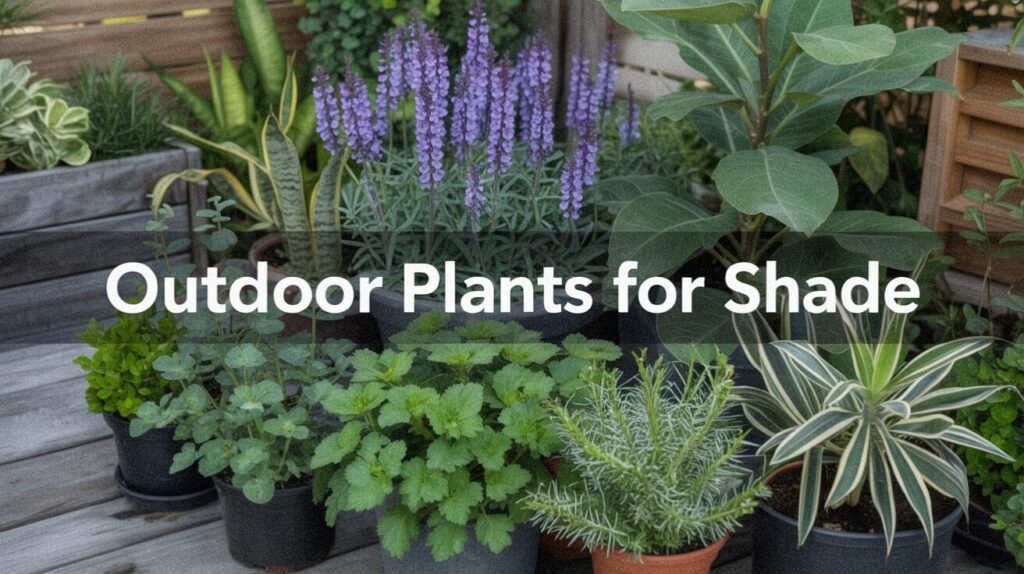Not every corner of your garden gets drenched in sunlight. Shady areas—whether under large trees, alongside fences, or tucked in narrow spaces—can sometimes feel tricky to design. But here’s the good news: outdoor plants for shade can transform those dim spots into lush, inviting retreats full of texture, color, and life.
Many gardeners mistakenly believe that plants need hours of full sun to thrive. While some do, countless others actually prefer shady conditions and can grow vigorously in low-light or partial-sun areas. From leafy ferns to blooming impatiens, shade-loving plants are just as versatile, decorative, and low-maintenance as their sun-loving counterparts.
In this guide, we’ll explore the best outdoor plants for shade, tips for choosing and caring for them, and creative ways to make shaded areas come alive. Whether you’re a beginner gardener or a seasoned plant enthusiast, you’ll find inspiration to turn your shady garden corners into stunning green oases.
Why Choose Outdoor Plants for Shade?
Shade-loving plants aren’t just fillers for dark corners; they bring unique benefits:
- 🌱 Diverse textures: From large hosta leaves to delicate ferns, shade plants create visual interest.
- 🌸 Pops of color: Many bloom beautifully in the shade, brightening otherwise dull spaces.
- 🌍 Eco-friendly: They thrive naturally in low-light areas without requiring artificial light.
- 🪴 Low-maintenance: Shade often means less evaporation, so you water less often.
If you’ve been struggling with empty or bare-looking shady spots, planting the right species can completely transform the ambiance.
Types of Shade in the Garden
Before selecting your plants, it’s essential to understand what kind of shade you have:
Full Shade
Areas that receive little to no direct sunlight, like under dense tree canopies or against north-facing walls.
Partial Shade
Places that get 3–6 hours of sunlight daily, often in the morning or filtered through trees.
Dappled Shade
Spots where sunlight flickers through leaves or lattice, creating alternating patches of light and shadow.
Understanding your shade type ensures you choose plants that will thrive rather than struggle.
Best Outdoor Plants for Shade
Here are some of the most popular and reliable plants for shaded gardens:
1. Hostas (Plantain Lilies)
- Known for their large, bold leaves in shades of green, blue, and variegated patterns.
- Thrive in partial to full shade.
- Low-maintenance and great for borders.
2. Ferns
- Add soft, feathery textures to shady areas.
- Species like maidenhair fern or Boston fern are especially elegant.
- Prefer moist, well-drained soil.
3. Impatiens
- Among the most popular shade-loving flowers.
- Offer vibrant blooms in red, pink, white, and purple.
- Perfect for shady beds, containers, or hanging baskets.
4. Astilbes
- Known for their tall, feathery plumes of pink, white, or red.
- Add vertical interest to shady spots.
- Thrive in consistently moist soil.
5. Heucheras (Coral Bells)
- Stunning foliage in shades of purple, bronze, or lime green.
- Tolerate partial shade and offer small delicate flowers.
- Great for edging or rock gardens.
6. Caladiums
- Famous for their heart-shaped, colorful leaves.
- Best in warm climates with dappled shade.
- Add a tropical flair to shaded spaces.
7. Begonias
- Both foliage and flowers are attractive.
- Grow well in containers and hanging pots in shaded areas.
- Require regular watering but tolerate low light beautifully.
8. Bleeding Hearts (Dicentra spectabilis)
- Graceful, heart-shaped flowers that dangle like jewels.
- Ideal for woodland-style gardens.
- Prefer partial to full shade with moist soil.
9. Hydrangeas
- Thrive in partial shade, producing large clusters of pink, blue, or white flowers.
- Excellent for borders and accent planting.
- Love moist, rich soil.
10. Lamium (Dead Nettle)
- A ground cover plant with silver-patterned leaves and tiny purple blooms.
- Perfect for covering shaded bare patches.
- Tolerates both partial and full shade.
Practical Tips for Growing Outdoor Plants in Shade
Even shade-loving plants need proper care to thrive. Here are some essential tips:
1. Improve Soil Quality
Shady areas often have compact or nutrient-poor soil. Mix in compost or organic matter to boost fertility and drainage.
2. Water Wisely
Shaded spots may retain moisture longer. Check soil before watering to avoid overwatering.
3. Add Mulch
Mulching helps retain soil moisture and prevents weed growth. Use bark chips or shredded leaves.
4. Use Contrast for Design
Combine plants with different leaf shapes and colors for visual appeal. For example, pair hostas with ferns or coral bells.
5. Don’t Forget Lighting
While shade plants tolerate less sunlight, some still need bright, indirect light. Place them accordingly to avoid leggy growth.
Designing with Shade-Loving Plants
Shady gardens can be just as stunning as sunny ones. Here’s how to design yours:
Create Layers
- Use tall plants like hydrangeas at the back.
- Medium plants like hostas in the middle.
- Ground covers like lamium at the front.
Add Pops of Color
- Mix flowering plants like impatiens or begonias with foliage plants for contrast.
- Use variegated leaves (like hostas or caladiums) to brighten dark corners.
Use Containers and Hanging Baskets
- Begonias, impatiens, and ferns thrive in pots.
- Hanging baskets filled with trailing plants like ivy can add vertical interest.
Incorporate Pathways
Stone or gravel paths framed with shade plants create a magical woodland feel.
Benefits of Outdoor Shade Plants
Beyond aesthetics, shade plants bring practical benefits:
- 🌿 Soil protection: Ground covers reduce erosion in shaded areas.
- 🌸 Extended bloom season: Many bloom later in summer when sunny plants fade.
- 🌱 Wildlife habitat: Flowers attract pollinators, while foliage shelters small creatures.
- 🌍 Cooling effect: Dense shade plants help keep surrounding areas cooler.
Step-by-Step Guide: Planting in Shady Areas
- Assess your shade: Identify if it’s full, partial, or dappled.
- Prepare soil: Add compost to enrich the bed.
- Select plants: Choose varieties suited for your specific shade type.
- Plant strategically: Taller plants at the back, shorter in front.
- Water carefully: Keep soil moist but not waterlogged.
- Add mulch: Conserve moisture and reduce weeds.
- Maintain: Trim dead leaves, fertilize lightly, and check for pests.
Frequently Asked Questions (FAQ)
1. What plants grow best in full shade outdoors?
Ferns, hostas, lamium, and bleeding hearts thrive in full shade with minimal sun exposure.
2. Can outdoor shade plants survive in containers?
Yes! Many shade plants, like begonias and impatiens, grow beautifully in pots and hanging baskets.
3. Do shade plants need fertilizer?
Yes, but not as often as sun-loving plants. A balanced, slow-release fertilizer once or twice per season is enough.
4. How can I add color to a shady garden?
Choose plants with vibrant foliage (caladiums, heucheras) and shade-blooming flowers (impatiens, astilbes).
5. What is the easiest outdoor plant for shade?
Hostas are among the easiest—they’re hardy, low-maintenance, and thrive in most shady conditions.
Conclusion
Shady areas don’t have to be dull or lifeless. With the right outdoor plants for shade, you can create enchanting garden spaces filled with lush greenery, vibrant flowers, and intriguing textures. From the bold leaves of hostas to the delicate blooms of impatiens, there’s no shortage of choices to suit your style and needs.
Whether you’re filling a bare corner, designing a woodland-inspired retreat, or simply looking to expand your gardening skills, shade-loving plants open up endless possibilities.
🌿 Ready to start your shade garden? Explore more plant care guides and design inspiration at Green Plant Zone—your go-to resource for all things plants!

Hi, I’m the creator of Green Plant Zone, a space dedicated to plant lovers. I share tips on indoor and outdoor gardening, plant care guides, and eco-friendly living. My mission is to help you grow healthier, happier plants and bring more greenery into everyday life.
